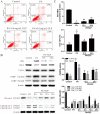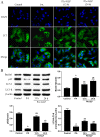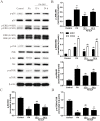Ganoderma lucidum Polysaccharides Prevent Palmitic Acid-Evoked Apoptosis and Autophagy in Intestinal Porcine Epithelial Cell Line via Restoration of Mitochondrial Function and Regulation of MAPK and AMPK/Akt/mTOR Signaling Pathway
- PMID: 30678035
- PMCID: PMC6387170
- DOI: 10.3390/ijms20030478
Ganoderma lucidum Polysaccharides Prevent Palmitic Acid-Evoked Apoptosis and Autophagy in Intestinal Porcine Epithelial Cell Line via Restoration of Mitochondrial Function and Regulation of MAPK and AMPK/Akt/mTOR Signaling Pathway
Abstract
Ganoderma lucidum polysaccharide (GLP) extracted from Ganoderma lucidum (Leyss. ex Fr.) Karst, a traditional Chinese medicine, is a biologically active substance reported to possess anti-oxidative, anti-apoptotic, and neurological protection. However, it is unknown whether GLP have any protective effect against high-fat constituents-induced epithelial cell injury. The aim of this study was to investigate the protection and molecular mechanism of GLP on injury induced by palmitic acid (PA) in the intestinal porcine epithelial cell line (IPEC-J2). First, we tested whether the treatment of GLP attenuate PA-induced IPEC-J2 cell death. GLP markedly blocked PA-caused cytotoxicity and apoptosis in IPEC-J2 cells. Moreover, GLP recovered the decreased mitochondrial function and inhibited activation of caspase-dependent apoptotic pathway. Interestingly, PA promoted cell apoptosis and autophagy through stimulation of phosphorylation of mitogen-activated protein kinases (MAPKs), AMP-activated protein kinase (AMPK), and inhibition of phosphorylation of Akt and mammalian target of rapamycin (mTOR), which was reversed by GLP. Taken together, this study revealed a protective effect of GLP against PA-evoked IPEC-J2 cell death through anti-apoptotic and anti-autophagic properties.
Keywords: Ganoderma lucidum; apoptosis; autophagy; mitochondria; polysaccharides.
Conflict of interest statement
The authors declare no conflict of interest. The funders had no role in the design of the study; in the collection, analyses, or interpretation of data; in the writing of the manuscript, or in the decision to publish the results.
Figures






Similar articles
-
Pro-apoptotic and pro-autophagic effects of the Aurora kinase A inhibitor alisertib (MLN8237) on human osteosarcoma U-2 OS and MG-63 cells through the activation of mitochondria-mediated pathway and inhibition of p38 MAPK/PI3K/Akt/mTOR signaling pathway.Drug Des Devel Ther. 2015 Mar 12;9:1555-84. doi: 10.2147/DDDT.S74197. eCollection 2015. Drug Des Devel Ther. 2015. PMID: 25792811 Free PMC article.
-
[Regulation of apoptosis and autophagy in hepatoblastoma cells by Ganoderma lucidum polysaccharides through Akt/mTOR pathway].Zhongguo Zhong Yao Za Zhi. 2025 May;50(9):2432-2441. doi: 10.19540/j.cnki.cjcmm.20241223.401. Zhongguo Zhong Yao Za Zhi. 2025. PMID: 40461199 Chinese.
-
ERK1/2-mediated autophagy is essential for cell survival under Ochratoxin A exposure in IPEC-J2 cells.Toxicol Appl Pharmacol. 2018 Dec 1;360:38-44. doi: 10.1016/j.taap.2018.09.027. Epub 2018 Sep 22. Toxicol Appl Pharmacol. 2018. PMID: 30248419
-
Colorectal cancer inhibitory properties of polysaccharides and their molecular mechanisms: A review.Int J Biol Macromol. 2023 May 31;238:124165. doi: 10.1016/j.ijbiomac.2023.124165. Epub 2023 Mar 22. Int J Biol Macromol. 2023. PMID: 36963537 Review.
-
Research progress of Ganoderma lucidum polysaccharide in prevention and treatment of Atherosclerosis.Heliyon. 2024 Jun 19;10(12):e33307. doi: 10.1016/j.heliyon.2024.e33307. eCollection 2024 Jun 30. Heliyon. 2024. PMID: 39022015 Free PMC article. Review.
Cited by
-
Interactions between Endoplasmic Reticulum Stress and Autophagy: Implications for Apoptosis and Neuroplasticity-Related Proteins in Palmitic Acid-Treated Prefrontal Cells.Neural Plast. 2021 Oct 4;2021:8851327. doi: 10.1155/2021/8851327. eCollection 2021. Neural Plast. 2021. PMID: 34646319 Free PMC article.
-
Antiaging Effects of Dietary Polysaccharides: Advance and Mechanisms.Oxid Med Cell Longev. 2022 Jul 12;2022:4362479. doi: 10.1155/2022/4362479. eCollection 2022. Oxid Med Cell Longev. 2022. PMID: 35864870 Free PMC article. Review.
-
Non-Apoptotic Programmed Cell Death in Thyroid Diseases.Pharmaceuticals (Basel). 2022 Dec 15;15(12):1565. doi: 10.3390/ph15121565. Pharmaceuticals (Basel). 2022. PMID: 36559016 Free PMC article. Review.
-
Effects of Enteromorpha prolifera polysaccharides on growth performance, intestinal barrier function and cecal microbiota in yellow-feathered broilers under heat stress.J Anim Sci Biotechnol. 2023 Oct 10;14(1):132. doi: 10.1186/s40104-023-00932-2. J Anim Sci Biotechnol. 2023. PMID: 37814279 Free PMC article.
-
Polysaccharides of Dendrobium officinale Kimura & Migo Leaves Protect Against Ethanol-Induced Gastric Mucosal Injury via the AMPK/mTOR Signaling Pathway in Vitro and vivo.Front Pharmacol. 2020 Nov 11;11:526349. doi: 10.3389/fphar.2020.526349. eCollection 2020. Front Pharmacol. 2020. PMID: 33262700 Free PMC article.
References
-
- Akbari P., Fink-Gremmels J., Willems R.H.A.M., Difilippo E., Schols M.H.C., Garssen J., Braber S. Characterizing microbiota-independent effects of oligosaccharides on intestinal epithelial cells: Insight into the role of structure and size. Eur. J. Nutr. 2017;56:1919–1930. doi: 10.1007/s00394-016-1234-9. - DOI - PMC - PubMed
-
- Nguyen H.T.T., Dalmasso G., Müller S., Carrière J., Seibold F., Darfeuille-Michaud A. Crohn’s disease-associated adherent invasive escherichia coli modulate levels of microRNAs in intestinal epithelial cells to reduce autophagy. Gastroenterology. 2014;146:508–519. doi: 10.1053/j.gastro.2013.10.021. - DOI - PubMed
-
- Elkahoui S., Bartley G.E., Yokoyama W.H., Friedman M. Dietary supplementation of potato peel powders prepared from conventional and organic russet and non-organic gold and red potatoes reduces weight gain in mice on a high-fat diet. J. Agric. Food Chem. 2018;66:6064–6072. doi: 10.1021/acs.jafc.8b01987. - DOI - PubMed
MeSH terms
Substances
Grants and funding
- 31501484/National Natural Science Foundation of China
- 2016JJ3081/Hunan Provincial Natural Science Foundation of China
- 2017GC03/Hunan Agricultural Science and Technology Innovation Team Project
- 2018QN27/Hunan Agricultural Science and Technology Innovation Team Project
- 2018ZD04/Hunan Agricultural Science and Technology Innovation Team Project
LinkOut - more resources
Full Text Sources
Miscellaneous

